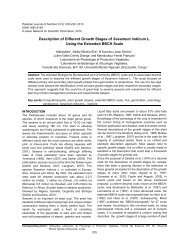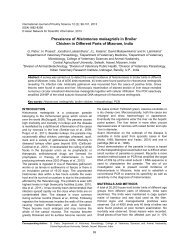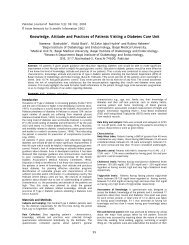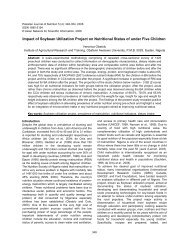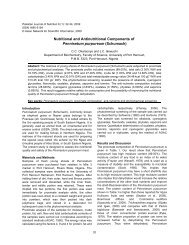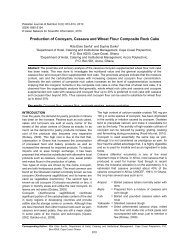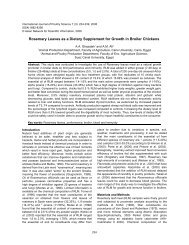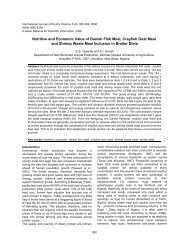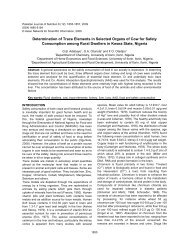effect of dietary calcium sources and levels on egg production and
effect of dietary calcium sources and levels on egg production and
effect of dietary calcium sources and levels on egg production and
Create successful ePaper yourself
Turn your PDF publications into a flip-book with our unique Google optimized e-Paper software.
Internati<strong>on</strong>al Journal <str<strong>on</strong>g>of</str<strong>on</strong>g> Poultry Science 6 (2): 131-136, 2007<br />
ISSN 1682-8356<br />
© Asian Network for Scientific Informati<strong>on</strong>, 2007<br />
Effect <str<strong>on</strong>g>of</str<strong>on</strong>g> Dietary Calcium Sources <str<strong>on</strong>g>and</str<strong>on</strong>g> Levels <strong>on</strong> Egg Producti<strong>on</strong><br />
<str<strong>on</strong>g>and</str<strong>on</strong>g> Egg Shell Quality <str<strong>on</strong>g>of</str<strong>on</strong>g> Japanese Quail<br />
1<br />
F. Sultana *, M.S. Islam <str<strong>on</strong>g>and</str<strong>on</strong>g> M.A.R. Howlider<br />
Department <str<strong>on</strong>g>of</str<strong>on</strong>g> Poultry Science, Bangladesh Agricultural University, Mymensingh, 2202, Bangladesh<br />
Abstract: The research was c<strong>on</strong>ducted at Bangladesh Agricultural University Poultry Farm, Mymensingh to<br />
evaluate the <str<strong>on</strong>g>effect</str<strong>on</strong>g> <str<strong>on</strong>g>of</str<strong>on</strong>g> different <str<strong>on</strong>g>levels</str<strong>on</strong>g> <str<strong>on</strong>g>and</str<strong>on</strong>g> <str<strong>on</strong>g>sources</str<strong>on</strong>g> <str<strong>on</strong>g>of</str<strong>on</strong>g> <str<strong>on</strong>g>calcium</str<strong>on</strong>g> <strong>on</strong> <strong>egg</strong> producti<strong>on</strong> <str<strong>on</strong>g>and</str<strong>on</strong>g> <strong>egg</strong> shell quality <str<strong>on</strong>g>of</str<strong>on</strong>g><br />
Japanese quail (Coturnix coturnix jap<strong>on</strong>ica) up to 23 weeks <str<strong>on</strong>g>of</str<strong>on</strong>g> age. For that purpose a total number <str<strong>on</strong>g>of</str<strong>on</strong>g> 108<br />
Japanese quails aged 20 week were fed <strong>on</strong> diets c<strong>on</strong>taining different <str<strong>on</strong>g>levels</str<strong>on</strong>g> (2.5%, 2.75% <str<strong>on</strong>g>and</str<strong>on</strong>g> 3.0%) <str<strong>on</strong>g>of</str<strong>on</strong>g><br />
<str<strong>on</strong>g>dietary</str<strong>on</strong>g> <str<strong>on</strong>g>calcium</str<strong>on</strong>g> from different <str<strong>on</strong>g>sources</str<strong>on</strong>g> eg. Oyster shell, limest<strong>on</strong>e <str<strong>on</strong>g>and</str<strong>on</strong>g> Calcium premix. They were placed in<br />
the experimental cages. Six birds were c<strong>on</strong>sidered for a replicati<strong>on</strong> <str<strong>on</strong>g>of</str<strong>on</strong>g> each treatment. The birds were reared<br />
in clean laying cages an open sided house. The experimental quails were exposed to identical care <str<strong>on</strong>g>and</str<strong>on</strong>g><br />
management throughout the experimental period. Feed <str<strong>on</strong>g>and</str<strong>on</strong>g> water were <str<strong>on</strong>g>of</str<strong>on</strong>g>fered ad libitum. Eggs were<br />
collected twice daily at morning <str<strong>on</strong>g>and</str<strong>on</strong>g> evening. The number <str<strong>on</strong>g>of</str<strong>on</strong>g> <strong>egg</strong>s laid by birds in each replicati<strong>on</strong> was<br />
recorded daily. The external quality <str<strong>on</strong>g>of</str<strong>on</strong>g> collected <strong>egg</strong>s were measured weekly from each treatment <str<strong>on</strong>g>and</str<strong>on</strong>g> level<br />
r<str<strong>on</strong>g>and</str<strong>on</strong>g>omly. No significant difference (p>0.05) in <strong>egg</strong> weight, shell weight, shell percentage, except <strong>egg</strong><br />
producti<strong>on</strong> <str<strong>on</strong>g>and</str<strong>on</strong>g> shell thickness was noted due to variati<strong>on</strong> <str<strong>on</strong>g>of</str<strong>on</strong>g> different <str<strong>on</strong>g>levels</str<strong>on</strong>g> <str<strong>on</strong>g>and</str<strong>on</strong>g> <str<strong>on</strong>g>calcium</str<strong>on</strong>g> <str<strong>on</strong>g>sources</str<strong>on</strong>g>. But as the<br />
birds were getting older <str<strong>on</strong>g>calcium</str<strong>on</strong>g> premix produced better shell quality than oyster shell <str<strong>on</strong>g>and</str<strong>on</strong>g> limest<strong>on</strong>e. It was<br />
c<strong>on</strong>cluded that any <str<strong>on</strong>g>of</str<strong>on</strong>g> these <str<strong>on</strong>g>calcium</str<strong>on</strong>g> <str<strong>on</strong>g>sources</str<strong>on</strong>g> can be c<strong>on</strong>sidered for laying Japanese quail but <str<strong>on</strong>g>calcium</str<strong>on</strong>g> premix<br />
produces better shell quality at later age. This result also suggested that a level <str<strong>on</strong>g>of</str<strong>on</strong>g> 2.5% <str<strong>on</strong>g>calcium</str<strong>on</strong>g> increases<br />
<strong>egg</strong> weight <str<strong>on</strong>g>and</str<strong>on</strong>g> shell thickness, while 2.75% increases body weight <str<strong>on</strong>g>and</str<strong>on</strong>g> shell weight <str<strong>on</strong>g>and</str<strong>on</strong>g> 3% increases <strong>egg</strong><br />
producti<strong>on</strong> <str<strong>on</strong>g>and</str<strong>on</strong>g> shell percentage.<br />
Key words: Quail, <strong>egg</strong> producti<strong>on</strong>, <strong>egg</strong> shell quality, oyster shell, limest<strong>on</strong>e, <str<strong>on</strong>g>calcium</str<strong>on</strong>g> premix<br />
Introducti<strong>on</strong><br />
Egg breakage still represents a major ec<strong>on</strong>omic loss to<br />
the poultry industry. It was estimated that 13 to 20% <str<strong>on</strong>g>of</str<strong>on</strong>g><br />
total <strong>egg</strong> producti<strong>on</strong> was cracked or lost before reaching<br />
their final destinati<strong>on</strong> (Rol<str<strong>on</strong>g>and</str<strong>on</strong>g>, 1988). So, laying hens<br />
should be given proper <str<strong>on</strong>g>calcium</str<strong>on</strong>g> rich feed in their diet not<br />
<strong>on</strong>ly for the formati<strong>on</strong> <str<strong>on</strong>g>of</str<strong>on</strong>g> <strong>egg</strong> shell but also for the high<br />
quality <str<strong>on</strong>g>of</str<strong>on</strong>g> <strong>egg</strong> shell, necessary for the preventi<strong>on</strong> <str<strong>on</strong>g>of</str<strong>on</strong>g><br />
breakage during h<str<strong>on</strong>g>and</str<strong>on</strong>g>ling <str<strong>on</strong>g>and</str<strong>on</strong>g> hatching. In general, the<br />
symptoms <str<strong>on</strong>g>of</str<strong>on</strong>g> <str<strong>on</strong>g>calcium</str<strong>on</strong>g> deficiency cause thin <strong>egg</strong> shell,<br />
reduced <strong>egg</strong> producti<strong>on</strong>, loss <str<strong>on</strong>g>of</str<strong>on</strong>g> appetite, leg weakness,<br />
cage layer fatigue <str<strong>on</strong>g>and</str<strong>on</strong>g> osteoporosis. Feeding with mild<br />
<str<strong>on</strong>g>calcium</str<strong>on</strong>g> deficiency, <strong>egg</strong> producti<strong>on</strong> generally decreases<br />
but does not stop completely. However, sometimes<br />
hens could lay at a high rate, even though they fed <strong>on</strong> a<br />
low <str<strong>on</strong>g>calcium</str<strong>on</strong>g> diet. In such cases, <str<strong>on</strong>g>calcium</str<strong>on</strong>g> is removed<br />
from the b<strong>on</strong>es resulting in hens becoming lame <str<strong>on</strong>g>and</str<strong>on</strong>g><br />
crippled <str<strong>on</strong>g>and</str<strong>on</strong>g> sometimes death ensures (Singh <str<strong>on</strong>g>and</str<strong>on</strong>g><br />
P<str<strong>on</strong>g>and</str<strong>on</strong>g>a, 1988).<br />
A number <str<strong>on</strong>g>of</str<strong>on</strong>g> <str<strong>on</strong>g>calcium</str<strong>on</strong>g> <str<strong>on</strong>g>sources</str<strong>on</strong>g> are being used to meet up<br />
the requirement <str<strong>on</strong>g>of</str<strong>on</strong>g> <str<strong>on</strong>g>dietary</str<strong>on</strong>g> <str<strong>on</strong>g>calcium</str<strong>on</strong>g> for birds. Am<strong>on</strong>g<br />
these, oyster shell <str<strong>on</strong>g>and</str<strong>on</strong>g> limest<strong>on</strong>e are the excellent<br />
<str<strong>on</strong>g>sources</str<strong>on</strong>g> <str<strong>on</strong>g>of</str<strong>on</strong>g> <str<strong>on</strong>g>calcium</str<strong>on</strong>g> <str<strong>on</strong>g>and</str<strong>on</strong>g> are extensively used in poultry<br />
diet (McNaught<strong>on</strong> et al., 1974; Gerry, 1980; Rol<str<strong>on</strong>g>and</str<strong>on</strong>g>,<br />
1989). The other <str<strong>on</strong>g>calcium</str<strong>on</strong>g> <str<strong>on</strong>g>sources</str<strong>on</strong>g> are steamed animal<br />
b<strong>on</strong>e meal, di<str<strong>on</strong>g>calcium</str<strong>on</strong>g> phosphate, rock phosphate,<br />
<str<strong>on</strong>g>calcium</str<strong>on</strong>g> phosphate, marine shell, <str<strong>on</strong>g>calcium</str<strong>on</strong>g> carb<strong>on</strong>ate,<br />
pulverized <strong>egg</strong>- shell, zeolite, arag<strong>on</strong>ite, gypsum, marble<br />
chips <str<strong>on</strong>g>and</str<strong>on</strong>g> even portl<str<strong>on</strong>g>and</str<strong>on</strong>g> cement (North <str<strong>on</strong>g>and</str<strong>on</strong>g> Bell, 1990;<br />
Angulo et al., 1987).<br />
Although problems associated with shell quality have<br />
been studied extensively in the hen, very limited<br />
informati<strong>on</strong> is available in quails. As in the case <str<strong>on</strong>g>of</str<strong>on</strong>g> hen,<br />
a deficiency <str<strong>on</strong>g>of</str<strong>on</strong>g> <str<strong>on</strong>g>calcium</str<strong>on</strong>g> in the diet <str<strong>on</strong>g>of</str<strong>on</strong>g> quails cause decline<br />
in <strong>egg</strong> producti<strong>on</strong>. The optimum level <str<strong>on</strong>g>of</str<strong>on</strong>g> <str<strong>on</strong>g>dietary</str<strong>on</strong>g> <str<strong>on</strong>g>calcium</str<strong>on</strong>g><br />
for high <strong>egg</strong> producti<strong>on</strong> <str<strong>on</strong>g>and</str<strong>on</strong>g> hatchability appears to be<br />
2.5 to 3 percent, while higher level caused reduced<br />
hatchability. Singh <str<strong>on</strong>g>and</str<strong>on</strong>g> P<str<strong>on</strong>g>and</str<strong>on</strong>g>a (1988) found am<strong>on</strong>g the<br />
three <str<strong>on</strong>g>calcium</str<strong>on</strong>g> <str<strong>on</strong>g>levels</str<strong>on</strong>g> <str<strong>on</strong>g>of</str<strong>on</strong>g> 2, 3.4 <str<strong>on</strong>g>and</str<strong>on</strong>g> 3.75. Only <str<strong>on</strong>g>calcium</str<strong>on</strong>g><br />
level 3 showed better result in increasing <strong>egg</strong> producti<strong>on</strong><br />
<str<strong>on</strong>g>and</str<strong>on</strong>g> <strong>egg</strong> shell quality.<br />
Farmers have to produce quality shelled <strong>egg</strong>. To do so,<br />
they have to select good quality <str<strong>on</strong>g>and</str<strong>on</strong>g> cheap <str<strong>on</strong>g>dietary</str<strong>on</strong>g><br />
<str<strong>on</strong>g>calcium</str<strong>on</strong>g> source. There are lots <str<strong>on</strong>g>of</str<strong>on</strong>g> <str<strong>on</strong>g>calcium</str<strong>on</strong>g> <str<strong>on</strong>g>sources</str<strong>on</strong>g><br />
available to choice as <str<strong>on</strong>g>dietary</str<strong>on</strong>g> supplement to boost up<br />
shell quality but still c<strong>on</strong>fr<strong>on</strong>tati<strong>on</strong> sometimes arises that<br />
which <strong>on</strong>e to be most <str<strong>on</strong>g>effect</str<strong>on</strong>g>ive. Oyster shell is harder<br />
than <strong>egg</strong>- shell, but it is well known that for <strong>egg</strong> shell<br />
++<br />
formati<strong>on</strong> blood Ca must be available in the uterus at<br />
night. With regard to the level <str<strong>on</strong>g>of</str<strong>on</strong>g> <str<strong>on</strong>g>calcium</str<strong>on</strong>g>, it is revealed<br />
1<br />
Corresp<strong>on</strong>ding Author:F. Sultana, Apartment No-151, Tsukuba Internati<strong>on</strong>al House, 2-1-9, Kann<strong>on</strong>dai, Tsukuba,<br />
Ibaraki 305-0035, Japan<br />
131
Sultana et al.: Effect <str<strong>on</strong>g>of</str<strong>on</strong>g> Dietary Calcium Sources <str<strong>on</strong>g>and</str<strong>on</strong>g> Levels<br />
that there is a gap <str<strong>on</strong>g>of</str<strong>on</strong>g> research with the intermediary level<br />
<str<strong>on</strong>g>of</str<strong>on</strong>g> 2.50 <str<strong>on</strong>g>and</str<strong>on</strong>g> 3. So the proposed level might be 2.5, 2.75<br />
<str<strong>on</strong>g>and</str<strong>on</strong>g> 3. Thus, there is a definite c<strong>on</strong>troversy regarding the<br />
level <str<strong>on</strong>g>of</str<strong>on</strong>g> <str<strong>on</strong>g>calcium</str<strong>on</strong>g> for Japanese quail. Therefore, more<br />
research are needed to solve this problem. Moreover,<br />
many works have been d<strong>on</strong>e <strong>on</strong>ly viewing shell quality.<br />
Very limited works have been undertaken regarding over<br />
all <strong>egg</strong> quality <str<strong>on</strong>g>and</str<strong>on</strong>g> <strong>egg</strong> producti<strong>on</strong> <str<strong>on</strong>g>of</str<strong>on</strong>g> laying quail.<br />
Keeping all above facts in mind, the present study was<br />
undertaken with the following objectives:<br />
1. To test the <str<strong>on</strong>g>effect</str<strong>on</strong>g> <str<strong>on</strong>g>of</str<strong>on</strong>g> oyster shell, limest<strong>on</strong>e <str<strong>on</strong>g>and</str<strong>on</strong>g><br />
<str<strong>on</strong>g>calcium</str<strong>on</strong>g> premix <strong>on</strong> body weight, <strong>egg</strong> producti<strong>on</strong> <str<strong>on</strong>g>and</str<strong>on</strong>g><br />
<strong>egg</strong> shell quality <str<strong>on</strong>g>of</str<strong>on</strong>g> Japanese quail.<br />
2. To find out the suitable source <str<strong>on</strong>g>and</str<strong>on</strong>g> the optimum<br />
level <str<strong>on</strong>g>of</str<strong>on</strong>g> <str<strong>on</strong>g>calcium</str<strong>on</strong>g> for Japanese quail.<br />
Materials <str<strong>on</strong>g>and</str<strong>on</strong>g> Methods<br />
The research was c<strong>on</strong>ducted for a period <str<strong>on</strong>g>of</str<strong>on</strong>g> 4 weeks at<br />
Bangladesh Agricultural University Poultry Farm,<br />
Mymensingh with 108 Japanese quails (Coturnix<br />
coturnix jap<strong>on</strong>ica) aged 20 weeks to evaluate the <str<strong>on</strong>g>effect</str<strong>on</strong>g><br />
<str<strong>on</strong>g>of</str<strong>on</strong>g> different <str<strong>on</strong>g>levels</str<strong>on</strong>g> <str<strong>on</strong>g>of</str<strong>on</strong>g> oyster shell, limest<strong>on</strong>e <str<strong>on</strong>g>and</str<strong>on</strong>g> <str<strong>on</strong>g>calcium</str<strong>on</strong>g><br />
premix <strong>on</strong> <strong>egg</strong> producti<strong>on</strong> <str<strong>on</strong>g>and</str<strong>on</strong>g> <strong>egg</strong> shell quality. They<br />
were placed in the experimental cages, 6 birds were<br />
c<strong>on</strong>sidered for a replicati<strong>on</strong> <str<strong>on</strong>g>of</str<strong>on</strong>g> each treatment. Required<br />
feed ingredients for preparing experimental diets were<br />
supplied by Bangladesh Agricultural University Poultry<br />
Farm. Oyster shell, limest<strong>on</strong>e <str<strong>on</strong>g>and</str<strong>on</strong>g> <str<strong>on</strong>g>calcium</str<strong>on</strong>g> premix were<br />
purchased from the local market <str<strong>on</strong>g>of</str<strong>on</strong>g> Mymensingh district<br />
town. Corn, Rice polish, Soyabean meal, Full fat<br />
Soyabean, Jassoprot, Til oil cake oyster shell or<br />
limest<strong>on</strong>e or <str<strong>on</strong>g>calcium</str<strong>on</strong>g> premix, comm<strong>on</strong> salt <str<strong>on</strong>g>and</str<strong>on</strong>g> vitaminmineral<br />
premix were mixed according to requirements <str<strong>on</strong>g>of</str<strong>on</strong>g><br />
NRC (1994). Feed ingredients in three <str<strong>on</strong>g>dietary</str<strong>on</strong>g><br />
treatments were same except for three test ingredients,<br />
e.g., oyster shell, limest<strong>on</strong>e <str<strong>on</strong>g>and</str<strong>on</strong>g> <str<strong>on</strong>g>calcium</str<strong>on</strong>g> premix <str<strong>on</strong>g>and</str<strong>on</strong>g><br />
also Corn because, Corn was adjusted according to the<br />
different level <str<strong>on</strong>g>of</str<strong>on</strong>g> testing ingredients (Table 1, 2 <str<strong>on</strong>g>and</str<strong>on</strong>g> 3). All<br />
feed ingredients were h<str<strong>on</strong>g>and</str<strong>on</strong>g> mixed thoroughly <str<strong>on</strong>g>and</str<strong>on</strong>g><br />
vitamin-mineral premix was mixed properly. Mixed feed<br />
was prepared weekly. The experimental diets were<br />
prepared weekly <str<strong>on</strong>g>and</str<strong>on</strong>g> stored in plastic c<strong>on</strong>tainers. Feed<br />
<str<strong>on</strong>g>and</str<strong>on</strong>g> water were <str<strong>on</strong>g>of</str<strong>on</strong>g>fered adlibitum. Eggs were collected<br />
twice daily at 9.30 am <str<strong>on</strong>g>and</str<strong>on</strong>g> 3.30 pm. In experimental<br />
period, the birds were exposed to 14 hours day length<br />
followed by 2 hours <str<strong>on</strong>g>of</str<strong>on</strong>g> artificial light in the evening by<br />
using 60-watt electric bulb hanged 2 meter above the<br />
floor. The number <str<strong>on</strong>g>of</str<strong>on</strong>g> <strong>egg</strong>s laid by birds in each<br />
replicati<strong>on</strong> was recorded daily <str<strong>on</strong>g>and</str<strong>on</strong>g> expressed weekly<br />
hen day <strong>egg</strong> producti<strong>on</strong> per cent. Eggs from each<br />
replicati<strong>on</strong> were collected <str<strong>on</strong>g>and</str<strong>on</strong>g> brought to laboratory for<br />
examinati<strong>on</strong> <strong>on</strong> each 7 days period. Three <strong>egg</strong>s from<br />
each replicati<strong>on</strong> <str<strong>on</strong>g>and</str<strong>on</strong>g> 27 from each treatment <str<strong>on</strong>g>and</str<strong>on</strong>g> level<br />
were r<str<strong>on</strong>g>and</str<strong>on</strong>g>omly collected in each 7day period. Eggs were<br />
washed, dried <str<strong>on</strong>g>and</str<strong>on</strong>g> then numbered <strong>on</strong> both ends.<br />
Clean <str<strong>on</strong>g>and</str<strong>on</strong>g> numbered <strong>egg</strong>s were weighed using an<br />
electric balance (Denver Instrument Co. USA). Weighed<br />
Table 1: Compositi<strong>on</strong> <str<strong>on</strong>g>of</str<strong>on</strong>g> experimental diets<br />
Ingredients (%)<br />
Calcium Premix<br />
-----------------------------------------<br />
3% 2.75% 2.5%<br />
Corn 0.4215 0.4345 0.4345<br />
Soyabean meal 0.2100 0.2100 0.2100<br />
Full fat soyabean 0.1000 0.1000 0.1000<br />
Rice polish 0.1000 0.1000 0.1000<br />
Calcium premix 0.0610 0.0540 0.0480<br />
Jessoport 0.0600 0.0600 0.0600<br />
Til oil cake 0.0400 0.0400 0.0400<br />
Comm<strong>on</strong> salt 0.0050 0.0050 0.0050<br />
Vitamin-premix 0.0025 0.0025 0.0025<br />
Calculated Compositi<strong>on</strong><br />
Metabolizable energy (Kcal/kg) 2842 2852 2861<br />
Crude protein (%) 23.09 23.02 23.20<br />
Crude fiber (%) 4.36 4.38 4.41<br />
Ether extract (%) 6.01 6.10 6.15<br />
Calcium (%) 3.01 2.76 2.51<br />
Lysine (%) 1.14 1.15 1.15<br />
Methi<strong>on</strong>ine (%) 0.33 0.34 0.33<br />
Tryptophan (%) 0.26 0.27 0.26<br />
Table 2: Compositi<strong>on</strong> <str<strong>on</strong>g>of</str<strong>on</strong>g> experimental diets<br />
Oyster shell<br />
-----------------------------------------<br />
Ingredients (%) 3% 2.75% 2.5%<br />
Corn 0.4185 0.4245 0.4315<br />
Soyabean meal 0.2100 0.2100 0.2100<br />
Full fat soyabean 0.1000 0.1000 0.1000<br />
Rice polish 0.1000 0.1000 0.1000<br />
Oyster shell 0.0640 0.0580 0.0510<br />
Jessoport 0.0600 0.0600 0.0600<br />
Til oil cake 0.0400 0.0400 0.0400<br />
Comm<strong>on</strong> salt 0.0050 0.0050 0.0050<br />
Vitamin-premix 0.0025 0.0025 0.0025<br />
Calculated Compositi<strong>on</strong><br />
Metabolizable energy (Kcal/kg) 2838 2858 2882<br />
Crude protein (%) 23.32 23.38 23.44<br />
Crude fiber (%) 4.38 4.39 4.04<br />
Ether extract (%) 6.15 6.17 6.20<br />
Calcium (%) 2.99 2.78 2.53<br />
Lysine (%) 1.14 1.14 1.14<br />
Methi<strong>on</strong>ine (%) 0.36 0.36 0.34<br />
Tryptophan (%) 0.26 0.26 0.26<br />
<strong>on</strong> all the <strong>egg</strong>s were recorded <str<strong>on</strong>g>and</str<strong>on</strong>g> average was<br />
calculated for each replicati<strong>on</strong>. The <strong>egg</strong>s were broken at<br />
the equator regi<strong>on</strong> by the help <str<strong>on</strong>g>of</str<strong>on</strong>g> spatula <str<strong>on</strong>g>and</str<strong>on</strong>g> the interior<br />
c<strong>on</strong>tents were allowed to drain out. The <strong>egg</strong> shell al<strong>on</strong>g<br />
with membrane was sunk in 5% EDTA soluti<strong>on</strong> for 30<br />
minutes. After then shell membrane was removed<br />
carefully. Egg shells were dried in the air <str<strong>on</strong>g>and</str<strong>on</strong>g> weight<br />
was taken using an electric balance (Denver Instrument<br />
Co. USA). The shell percentage was calculated using<br />
the following formula<br />
Weight <str<strong>on</strong>g>of</str<strong>on</strong>g> <strong>egg</strong> shell<br />
Shell percentage = ---------------------------- x 100<br />
Egg weight<br />
After drying, shell thickness was measured using an<br />
<strong>egg</strong> shell thickness meter (Ogawa sciki Co. Ltd. Tokyo,<br />
132
Sultana et al.: Effect <str<strong>on</strong>g>of</str<strong>on</strong>g> Dietary Calcium Sources <str<strong>on</strong>g>and</str<strong>on</strong>g> Levels<br />
Table 3: Compositi<strong>on</strong> <str<strong>on</strong>g>of</str<strong>on</strong>g> experimental diets<br />
Ingredients (%)<br />
Lime st<strong>on</strong>e<br />
-----------------------------------------<br />
3% 2.75% 2.5%<br />
Corn 0.4165 0.4235 0.4305<br />
Soyabean meal 0.2100 0.2100 0.2100<br />
Full fat soyabean 0.1000 0.1000 0.1000<br />
Rice polish 0.1000 0.1000 0.1000<br />
Lime st<strong>on</strong>e 0.0660 0.0590 0.0520<br />
Jessoport 0.0600 0.0600 0.0600<br />
Til oil cake 0.0400 0.0400 0.0400<br />
Comm<strong>on</strong> salt 0.0050 0.0050 0.0050<br />
Vitamin-premix 0.0025 0.0025 0.0025<br />
Calculated Compositi<strong>on</strong><br />
Metabolizable energy (Kcal/kg) 2831 2855 2861<br />
Crude protein (%) 23.31 23.37 23.42<br />
Crude fiber (%) 4.37 4.39 4.41<br />
Ether extract (%) 6.14 6.17 6.21<br />
Calcium (%) 2.99 2.75 2.51<br />
Lysine (%) 1.14 1.14 1.14<br />
Methi<strong>on</strong>ine (%) 0.36 0.36 0.36<br />
Tryptophan (%) 0.26 0.26 0.26<br />
Japan) in millimeter. To reduce error, three<br />
measurements were taken for each <strong>egg</strong> shell; <strong>on</strong>e <strong>on</strong><br />
large end, <strong>on</strong>e <strong>on</strong> small end <str<strong>on</strong>g>and</str<strong>on</strong>g> <strong>on</strong>e <strong>on</strong> the equator<br />
regi<strong>on</strong>. The mean <str<strong>on</strong>g>of</str<strong>on</strong>g> three measurements was<br />
c<strong>on</strong>sidered as the shell thickness <str<strong>on</strong>g>of</str<strong>on</strong>g> a particular <strong>egg</strong>. All<br />
recorded <str<strong>on</strong>g>and</str<strong>on</strong>g> calculated data were for a 3 (<str<strong>on</strong>g>calcium</str<strong>on</strong>g><br />
<str<strong>on</strong>g>sources</str<strong>on</strong>g>)×3 (<str<strong>on</strong>g>levels</str<strong>on</strong>g> <str<strong>on</strong>g>of</str<strong>on</strong>g> <str<strong>on</strong>g>calcium</str<strong>on</strong>g>) factorial experiment with<br />
multiple observati<strong>on</strong>s (2) per cell in a Completely<br />
R<str<strong>on</strong>g>and</str<strong>on</strong>g>omized Design (CRD). An Analysis <str<strong>on</strong>g>of</str<strong>on</strong>g> Variance<br />
(ANOVA) was performed to partiti<strong>on</strong> variances into<br />
<str<strong>on</strong>g>sources</str<strong>on</strong>g>, level; <str<strong>on</strong>g>sources</str<strong>on</strong>g>×level <str<strong>on</strong>g>and</str<strong>on</strong>g> error to compare<br />
different parameters am<strong>on</strong>g the treatments<br />
combinati<strong>on</strong>s. If ANOVA showed significant difference,<br />
Least Significant Difference (LSD) was calculated to<br />
isolate the differences test at 1 <str<strong>on</strong>g>and</str<strong>on</strong>g> 5% level provability<br />
(Gomez <str<strong>on</strong>g>and</str<strong>on</strong>g> Gomez, 1984).<br />
Results <str<strong>on</strong>g>and</str<strong>on</strong>g> Discussi<strong>on</strong><br />
The data obtained during the experimental period for<br />
different parameters were analyzed <str<strong>on</strong>g>and</str<strong>on</strong>g> the results were<br />
presented in Table 4 <str<strong>on</strong>g>and</str<strong>on</strong>g> 5. The results are stated under<br />
the following subheadings to evaluate the <str<strong>on</strong>g>effect</str<strong>on</strong>g>s <str<strong>on</strong>g>of</str<strong>on</strong>g><br />
different <str<strong>on</strong>g>dietary</str<strong>on</strong>g> <str<strong>on</strong>g>calcium</str<strong>on</strong>g> <str<strong>on</strong>g>sources</str<strong>on</strong>g>.<br />
Effect <str<strong>on</strong>g>of</str<strong>on</strong>g> different <str<strong>on</strong>g>dietary</str<strong>on</strong>g> <str<strong>on</strong>g>calcium</str<strong>on</strong>g> <str<strong>on</strong>g>sources</str<strong>on</strong>g> <str<strong>on</strong>g>and</str<strong>on</strong>g><br />
different <str<strong>on</strong>g>levels</str<strong>on</strong>g> <strong>on</strong> body weight <str<strong>on</strong>g>and</str<strong>on</strong>g> <strong>egg</strong> producti<strong>on</strong>:<br />
The data presented in Table 4 showed that <str<strong>on</strong>g>calcium</str<strong>on</strong>g><br />
source, their level <str<strong>on</strong>g>and</str<strong>on</strong>g> their interacti<strong>on</strong> did not influence<br />
(P>0.05) initial live weight, final live weight, average <strong>egg</strong><br />
th st rd<br />
producti<strong>on</strong> at 20 , 21 <str<strong>on</strong>g>and</str<strong>on</strong>g> 23 week <str<strong>on</strong>g>of</str<strong>on</strong>g> experimental<br />
period. However, <str<strong>on</strong>g>calcium</str<strong>on</strong>g> level significantly influenced<br />
nd<br />
(P>0.05) <strong>egg</strong> producti<strong>on</strong> at 22 week <str<strong>on</strong>g>of</str<strong>on</strong>g> age. Where <strong>egg</strong><br />
producti<strong>on</strong> was the highest <strong>on</strong> 2.75% <str<strong>on</strong>g>dietary</str<strong>on</strong>g> <str<strong>on</strong>g>calcium</str<strong>on</strong>g>,<br />
intermediate <strong>on</strong> 3% while it was lowest <strong>on</strong> 2.5% <str<strong>on</strong>g>dietary</str<strong>on</strong>g><br />
<str<strong>on</strong>g>calcium</str<strong>on</strong>g>. Calcium source <str<strong>on</strong>g>and</str<strong>on</strong>g> its interacti<strong>on</strong> with <str<strong>on</strong>g>calcium</str<strong>on</strong>g><br />
level had little <str<strong>on</strong>g>effect</str<strong>on</strong>g> (P>0.05) <strong>on</strong> <strong>egg</strong> producti<strong>on</strong> at 3 rd<br />
week <str<strong>on</strong>g>of</str<strong>on</strong>g> the experiment.<br />
Body weight: Initial <str<strong>on</strong>g>and</str<strong>on</strong>g> final body weight <str<strong>on</strong>g>of</str<strong>on</strong>g> quail was<br />
presented in Table 4. Data showed that average body<br />
weight <str<strong>on</strong>g>of</str<strong>on</strong>g> quails were statistically similar <str<strong>on</strong>g>and</str<strong>on</strong>g> average<br />
145.83 g/quail during the initial stage <str<strong>on</strong>g>of</str<strong>on</strong>g> trial. At the end<br />
<str<strong>on</strong>g>of</str<strong>on</strong>g> the experiment result showed that body weight n<strong>on</strong>significant<br />
(P>0.05) increased for every treatment<br />
irrespective <str<strong>on</strong>g>of</str<strong>on</strong>g> different <str<strong>on</strong>g>levels</str<strong>on</strong>g> <str<strong>on</strong>g>of</str<strong>on</strong>g> supply. However, data<br />
showed that 2.75% level <str<strong>on</strong>g>of</str<strong>on</strong>g> supplementati<strong>on</strong> <str<strong>on</strong>g>of</str<strong>on</strong>g> <str<strong>on</strong>g>calcium</str<strong>on</strong>g><br />
irrespective <str<strong>on</strong>g>of</str<strong>on</strong>g> different <str<strong>on</strong>g>sources</str<strong>on</strong>g> result showed n<strong>on</strong>significantly<br />
(P>0.05) higher body weight gain than the<br />
other two <str<strong>on</strong>g>levels</str<strong>on</strong>g>. In final weight gain, there is no<br />
significant (P>0.05) <str<strong>on</strong>g>effect</str<strong>on</strong>g> <str<strong>on</strong>g>of</str<strong>on</strong>g> the interacti<strong>on</strong> <str<strong>on</strong>g>of</str<strong>on</strong>g> different<br />
source <str<strong>on</strong>g>and</str<strong>on</strong>g> <str<strong>on</strong>g>levels</str<strong>on</strong>g>. Cheng <str<strong>on</strong>g>and</str<strong>on</strong>g> Co<strong>on</strong> (1990), supplied<br />
<str<strong>on</strong>g>dietary</str<strong>on</strong>g> <str<strong>on</strong>g>calcium</str<strong>on</strong>g> from various <str<strong>on</strong>g>sources</str<strong>on</strong>g> <str<strong>on</strong>g>and</str<strong>on</strong>g> found no<br />
significant different in body weight <str<strong>on</strong>g>and</str<strong>on</strong>g> <strong>egg</strong> producti<strong>on</strong>.<br />
Oliveira et al. (1997), supplied <str<strong>on</strong>g>dietary</str<strong>on</strong>g> <str<strong>on</strong>g>calcium</str<strong>on</strong>g> from<br />
different <str<strong>on</strong>g>sources</str<strong>on</strong>g> <str<strong>on</strong>g>and</str<strong>on</strong>g> found no significant different in<br />
<strong>egg</strong> producti<strong>on</strong> <str<strong>on</strong>g>and</str<strong>on</strong>g> body weight.<br />
Egg producti<strong>on</strong>: Hen day <strong>egg</strong> producti<strong>on</strong> per cent <str<strong>on</strong>g>of</str<strong>on</strong>g> the<br />
three treatments differ significantly P0.05) <str<strong>on</strong>g>effect</str<strong>on</strong>g> <str<strong>on</strong>g>of</str<strong>on</strong>g> different <str<strong>on</strong>g>levels</str<strong>on</strong>g> <str<strong>on</strong>g>of</str<strong>on</strong>g> <str<strong>on</strong>g>calcium</str<strong>on</strong>g><br />
irrespective <str<strong>on</strong>g>of</str<strong>on</strong>g> <str<strong>on</strong>g>calcium</str<strong>on</strong>g> <str<strong>on</strong>g>sources</str<strong>on</strong>g> <strong>on</strong> hen day <strong>egg</strong><br />
producti<strong>on</strong> per day. The similarity <str<strong>on</strong>g>of</str<strong>on</strong>g> <strong>egg</strong> producti<strong>on</strong> per<br />
cent revealed that different <str<strong>on</strong>g>dietary</str<strong>on</strong>g> <str<strong>on</strong>g>calcium</str<strong>on</strong>g> level had no<br />
<str<strong>on</strong>g>effect</str<strong>on</strong>g> <strong>on</strong> hen day <strong>egg</strong> producti<strong>on</strong>. This result is in<br />
agreement with some previous research findings.<br />
Scheideler (1998), Makled <str<strong>on</strong>g>and</str<strong>on</strong>g> Charles (1987) observed<br />
that <strong>egg</strong> producti<strong>on</strong> did not significantly (P0.05) <str<strong>on</strong>g>effect</str<strong>on</strong>g> <str<strong>on</strong>g>of</str<strong>on</strong>g> interacti<strong>on</strong> <str<strong>on</strong>g>of</str<strong>on</strong>g><br />
different <str<strong>on</strong>g>calcium</str<strong>on</strong>g> <str<strong>on</strong>g>sources</str<strong>on</strong>g> <str<strong>on</strong>g>and</str<strong>on</strong>g> <str<strong>on</strong>g>levels</str<strong>on</strong>g> <strong>on</strong> hen day <strong>egg</strong><br />
producti<strong>on</strong> per cent.<br />
Final body weight <str<strong>on</strong>g>and</str<strong>on</strong>g> <strong>egg</strong> producti<strong>on</strong>: C<strong>on</strong>sidering the<br />
<str<strong>on</strong>g>effect</str<strong>on</strong>g> <str<strong>on</strong>g>of</str<strong>on</strong>g> different <str<strong>on</strong>g>sources</str<strong>on</strong>g> <str<strong>on</strong>g>and</str<strong>on</strong>g> <str<strong>on</strong>g>levels</str<strong>on</strong>g> <str<strong>on</strong>g>of</str<strong>on</strong>g> <str<strong>on</strong>g>calcium</str<strong>on</strong>g> results<br />
indicated that the highest final body weight (162.50g)<br />
was found with the birds were fed <strong>on</strong> diet c<strong>on</strong>taining<br />
2.75% lime st<strong>on</strong>e, though the result was not significant.<br />
The percentages <str<strong>on</strong>g>of</str<strong>on</strong>g> average <strong>egg</strong> producti<strong>on</strong> <str<strong>on</strong>g>of</str<strong>on</strong>g> birds at<br />
st<br />
21 week <str<strong>on</strong>g>of</str<strong>on</strong>g> age supplied with the diet c<strong>on</strong>taining 2.5%<br />
<str<strong>on</strong>g>of</str<strong>on</strong>g> <str<strong>on</strong>g>calcium</str<strong>on</strong>g> premix was found highest (71.43) followed by<br />
67.86% with the diet c<strong>on</strong>taining 3% lime st<strong>on</strong>e. Similar<br />
trend was also observed with different <str<strong>on</strong>g>levels</str<strong>on</strong>g> <str<strong>on</strong>g>of</str<strong>on</strong>g> <str<strong>on</strong>g>calcium</str<strong>on</strong>g><br />
nd<br />
<str<strong>on</strong>g>sources</str<strong>on</strong>g> supplied to the birds at 22 weeks <str<strong>on</strong>g>of</str<strong>on</strong>g> age. But<br />
it was significantly highest (64.29%) with the diet<br />
th<br />
c<strong>on</strong>taining 2.75% <str<strong>on</strong>g>calcium</str<strong>on</strong>g> premix. At the age <str<strong>on</strong>g>of</str<strong>on</strong>g> 24 week<br />
the average percentage <str<strong>on</strong>g>of</str<strong>on</strong>g> <strong>egg</strong> producti<strong>on</strong> was found,<br />
highest (70.24%) with the diet c<strong>on</strong>taining 3% <str<strong>on</strong>g>calcium</str<strong>on</strong>g><br />
premix followed by 3% oyster shell (65.48%), but their<br />
differences were not significant. C<strong>on</strong>sidering the <str<strong>on</strong>g>effect</str<strong>on</strong>g><br />
<str<strong>on</strong>g>of</str<strong>on</strong>g> mean values <str<strong>on</strong>g>of</str<strong>on</strong>g> different <str<strong>on</strong>g>levels</str<strong>on</strong>g> <str<strong>on</strong>g>of</str<strong>on</strong>g> <str<strong>on</strong>g>calcium</str<strong>on</strong>g> premix,<br />
133
Sultana et al.: Effect <str<strong>on</strong>g>of</str<strong>on</strong>g> Dietary Calcium Sources <str<strong>on</strong>g>and</str<strong>on</strong>g> Levels<br />
Table 4: Interacti<strong>on</strong> <str<strong>on</strong>g>of</str<strong>on</strong>g> <str<strong>on</strong>g>calcium</str<strong>on</strong>g> <str<strong>on</strong>g>sources</str<strong>on</strong>g> <str<strong>on</strong>g>and</str<strong>on</strong>g> their <str<strong>on</strong>g>dietary</str<strong>on</strong>g> <str<strong>on</strong>g>levels</str<strong>on</strong>g> <strong>on</strong> body weight <str<strong>on</strong>g>and</str<strong>on</strong>g> <strong>egg</strong> producti<strong>on</strong> performance <str<strong>on</strong>g>of</str<strong>on</strong>g> quail with different<br />
treatments<br />
Variables Level <str<strong>on</strong>g>of</str<strong>on</strong>g> <str<strong>on</strong>g>dietary</str<strong>on</strong>g> <str<strong>on</strong>g>calcium</str<strong>on</strong>g> (%) (LC) (SED)/LSD <str<strong>on</strong>g>and</str<strong>on</strong>g> siginificance<br />
Source <str<strong>on</strong>g>of</str<strong>on</strong>g> ----------------------------------------------- -------------------------------------------------------<br />
<str<strong>on</strong>g>calcium</str<strong>on</strong>g> (SC) 3% 2.75% 2.50% Mean SC LC SCXLC<br />
Initial body Ca-premix 146 137.5 146 143.2 5.717 NS 5.717NS 9.902 NS<br />
weight/bird (g) Oyster shell 146 145.5 150 147.2<br />
Lime st<strong>on</strong>e 141.5 158.5 141.5 147.2<br />
Mean 144.5 147.2 145.8 145.8<br />
Final body Ca-premix 154 150 146 150 3.813 NS 3.1813 NS 6.604 NS<br />
weight/bird (g) Oyster shell 150 150 150 150<br />
Lime st<strong>on</strong>e 154 162.5 150 155.5<br />
Mean 152.7 154.2 148.7 151.8<br />
Average <strong>egg</strong> Ca-premix 61.92 66.67 71.43 66.67 3.802 NS 3.820NS 6.617 NS<br />
producti<strong>on</strong> Oyster shell 60.72 69.05 63.1 64.29<br />
at 1st week (%) Lime st<strong>on</strong>e 67.86 59.52 64.29 63.89<br />
Mean 63.49 65.08 66.27 64.95<br />
Average <strong>egg</strong> Ca-premix 59.52 59.53 58.33 59.13 1.9628 NS 1.9618 NS 3.398 NS<br />
producti<strong>on</strong> Oyster shell 56.45 54.76 53.38 54.86<br />
at 2nd week (%) Lime st<strong>on</strong>e 58.33 59.52 59.52 59.12<br />
Mean 58.10 57.94 57.07 57.7<br />
Average <strong>egg</strong> Ca-premix 63.1 64.29 59.52 62.3 1.870 NS 1.870* 3.239 NS<br />
producti<strong>on</strong> Oyster shell 59.52 57.64 53.38 56.85<br />
at 3rd week (%) Lime st<strong>on</strong>e 55.95 57.14 55.26 56.12<br />
Mean 59.52 59.69 56.05 58.42<br />
Average <strong>egg</strong> Ca-premix 70.24 61.91 61.91 64.68 3.305 NS 3.305 NS 5.725 NS<br />
producti<strong>on</strong> Oyster shell 65.48 61.9 53.52 60.32<br />
at 4th week (%) Lime st<strong>on</strong>e 60.72 61.9 57.15 59.92<br />
Mean 65.48 61.9 57.54 61.64<br />
Average <strong>egg</strong> Ca-premix 63.69 63.1 62.8 63.19 1.426 NS 1.426* 2.470NS<br />
producti<strong>on</strong> (%) Oyster shell 60.42 60.72 55.36 58.83<br />
Lime st<strong>on</strong>e 60.72 59.53 58.93 59.72<br />
Mean 61.61 61.11 59.03 60.58<br />
NS= N<strong>on</strong> significant (P>0.05) * = significant at 5% level (P0.05) * = significant at 5% level (P0.05) influence <strong>egg</strong> weight, shell weight<br />
<str<strong>on</strong>g>and</str<strong>on</strong>g> shell per cent but <str<strong>on</strong>g>dietary</str<strong>on</strong>g> <str<strong>on</strong>g>calcium</str<strong>on</strong>g> source had<br />
significant <str<strong>on</strong>g>effect</str<strong>on</strong>g> (p0.05) by the<br />
134
Sultana et al.: Effect <str<strong>on</strong>g>of</str<strong>on</strong>g> Dietary Calcium Sources <str<strong>on</strong>g>and</str<strong>on</strong>g> Levels<br />
variati<strong>on</strong> <str<strong>on</strong>g>of</str<strong>on</strong>g> <str<strong>on</strong>g>calcium</str<strong>on</strong>g> source <str<strong>on</strong>g>and</str<strong>on</strong>g> its interacti<strong>on</strong> with<br />
<str<strong>on</strong>g>calcium</str<strong>on</strong>g> level.<br />
Egg weight: Egg weight <strong>on</strong> different treatments Table 5<br />
did not differ significantly (P>0.05). Egg weights <str<strong>on</strong>g>of</str<strong>on</strong>g><br />
different treatment irrespective <str<strong>on</strong>g>of</str<strong>on</strong>g> different <str<strong>on</strong>g>levels</str<strong>on</strong>g> were<br />
9.53g for oyster shell, 10.19g for limest<strong>on</strong>e <str<strong>on</strong>g>and</str<strong>on</strong>g> 10.42g<br />
for <str<strong>on</strong>g>calcium</str<strong>on</strong>g> premix. Egg weights <strong>on</strong> different <str<strong>on</strong>g>levels</str<strong>on</strong>g> <str<strong>on</strong>g>of</str<strong>on</strong>g><br />
<str<strong>on</strong>g>calcium</str<strong>on</strong>g> irrespective <str<strong>on</strong>g>of</str<strong>on</strong>g> different <str<strong>on</strong>g>sources</str<strong>on</strong>g> <str<strong>on</strong>g>of</str<strong>on</strong>g> <str<strong>on</strong>g>calcium</str<strong>on</strong>g> were<br />
9.74g for 3%, 10.16g for 2.75% <str<strong>on</strong>g>and</str<strong>on</strong>g> 10.24g for 2.5%.<br />
Lack <str<strong>on</strong>g>of</str<strong>on</strong>g> influence <strong>on</strong> <str<strong>on</strong>g>dietary</str<strong>on</strong>g> <str<strong>on</strong>g>calcium</str<strong>on</strong>g> <str<strong>on</strong>g>sources</str<strong>on</strong>g> <strong>on</strong> <strong>egg</strong><br />
weight obtained in current finding is in agreement with<br />
some researchers. Richter et al. (1999) used <str<strong>on</strong>g>dietary</str<strong>on</strong>g><br />
<str<strong>on</strong>g>calcium</str<strong>on</strong>g> from various source <str<strong>on</strong>g>and</str<strong>on</strong>g> found no significant<br />
difference in <strong>egg</strong> weight. Scheideler (1998) <str<strong>on</strong>g>and</str<strong>on</strong>g> Rab<strong>on</strong><br />
et al. (1991) also observed that <strong>egg</strong> weight did not<br />
significantly differ due to various <str<strong>on</strong>g>calcium</str<strong>on</strong>g> <str<strong>on</strong>g>sources</str<strong>on</strong>g>.<br />
However, there was no significant (P>0.05) difference<br />
found <strong>on</strong> average <strong>egg</strong> weight by the interacti<strong>on</strong> <str<strong>on</strong>g>of</str<strong>on</strong>g><br />
different <str<strong>on</strong>g>calcium</str<strong>on</strong>g> source <str<strong>on</strong>g>and</str<strong>on</strong>g> their different <str<strong>on</strong>g>levels</str<strong>on</strong>g>.<br />
Egg shell weight: Egg shell weight did not differ<br />
significantly (P>0.05) due to different <str<strong>on</strong>g>sources</str<strong>on</strong>g> <str<strong>on</strong>g>of</str<strong>on</strong>g> <str<strong>on</strong>g>calcium</str<strong>on</strong>g><br />
(Table5). Egg shell weights <str<strong>on</strong>g>of</str<strong>on</strong>g> different treatments<br />
irrespective <str<strong>on</strong>g>of</str<strong>on</strong>g> different <str<strong>on</strong>g>levels</str<strong>on</strong>g> were 0.74g for oyster shell,<br />
0.80g for limest<strong>on</strong>e <str<strong>on</strong>g>and</str<strong>on</strong>g> 0.80g for <str<strong>on</strong>g>calcium</str<strong>on</strong>g> premix. Egg<br />
shell weights <str<strong>on</strong>g>of</str<strong>on</strong>g> different <str<strong>on</strong>g>levels</str<strong>on</strong>g> <str<strong>on</strong>g>of</str<strong>on</strong>g> <str<strong>on</strong>g>calcium</str<strong>on</strong>g> irrespective<br />
different <str<strong>on</strong>g>sources</str<strong>on</strong>g> were 0.77g for 3%, 0.80g for 2.75%<br />
<str<strong>on</strong>g>and</str<strong>on</strong>g> 0.77g for 2.5%. The similar <str<strong>on</strong>g>of</str<strong>on</strong>g> shell weight was due<br />
to lack <str<strong>on</strong>g>of</str<strong>on</strong>g> influence <str<strong>on</strong>g>of</str<strong>on</strong>g> various <str<strong>on</strong>g>calcium</str<strong>on</strong>g> <str<strong>on</strong>g>sources</str<strong>on</strong>g> <strong>on</strong> shell<br />
weight. Richter et al. (1999) used <str<strong>on</strong>g>calcium</str<strong>on</strong>g> from various<br />
<str<strong>on</strong>g>sources</str<strong>on</strong>g> <str<strong>on</strong>g>and</str<strong>on</strong>g> found no significant difference in shell<br />
weight. Anders<strong>on</strong> et al. (1982), Cheng <str<strong>on</strong>g>and</str<strong>on</strong>g> Co<strong>on</strong> (1971)<br />
observed no significant difference <strong>on</strong> shell quality when<br />
they substitute limest<strong>on</strong>e by oyster shell.<br />
However, there was no significant (P>0.05) difference<br />
found <strong>on</strong> average <strong>egg</strong> weight by the interacti<strong>on</strong> <str<strong>on</strong>g>of</str<strong>on</strong>g><br />
different <str<strong>on</strong>g>calcium</str<strong>on</strong>g> source <str<strong>on</strong>g>and</str<strong>on</strong>g> their different <str<strong>on</strong>g>levels</str<strong>on</strong>g>. The<br />
increasing <str<strong>on</strong>g>of</str<strong>on</strong>g> shell weight suggests that <str<strong>on</strong>g>calcium</str<strong>on</strong>g> premix<br />
helped to maintain shell weight as the birds were getting<br />
older.<br />
Egg shell percentage: Egg shell percentages <str<strong>on</strong>g>of</str<strong>on</strong>g> different<br />
treatments irrespective <str<strong>on</strong>g>of</str<strong>on</strong>g> different level were 7.83% for<br />
oyster shell, 7.83% for limest<strong>on</strong>e <str<strong>on</strong>g>and</str<strong>on</strong>g> 7.72% for <str<strong>on</strong>g>calcium</str<strong>on</strong>g><br />
premix (Table 5). Moreover shell percentages <str<strong>on</strong>g>of</str<strong>on</strong>g> different<br />
<str<strong>on</strong>g>levels</str<strong>on</strong>g> irrespective <str<strong>on</strong>g>of</str<strong>on</strong>g> different source <str<strong>on</strong>g>of</str<strong>on</strong>g> <str<strong>on</strong>g>calcium</str<strong>on</strong>g> were<br />
7.97% for 3.0%, 7.86% for 2.75% <str<strong>on</strong>g>and</str<strong>on</strong>g> 7.56% for 2.5%.<br />
The results did not differ significantly (P>0.05). As birds<br />
were fed <strong>on</strong> different <str<strong>on</strong>g>sources</str<strong>on</strong>g> <str<strong>on</strong>g>of</str<strong>on</strong>g> <str<strong>on</strong>g>dietary</str<strong>on</strong>g> <str<strong>on</strong>g>calcium</str<strong>on</strong>g>, no<br />
differences were observed <strong>on</strong> shell percentage between<br />
<str<strong>on</strong>g>dietary</str<strong>on</strong>g> <str<strong>on</strong>g>calcium</str<strong>on</strong>g> <str<strong>on</strong>g>sources</str<strong>on</strong>g>. The results are partially<br />
c<strong>on</strong>sistent with Cheng <str<strong>on</strong>g>and</str<strong>on</strong>g> Co<strong>on</strong> (1990); they replaced<br />
limest<strong>on</strong>e by oyster shell in layer diet. Anders<strong>on</strong> (1982)<br />
also observed that different <str<strong>on</strong>g>calcium</str<strong>on</strong>g> <str<strong>on</strong>g>sources</str<strong>on</strong>g> gave<br />
equivalent shell percentage. However, there was no<br />
significant (P>0.05) difference found <strong>on</strong> average <strong>egg</strong><br />
weight by the interacti<strong>on</strong> <str<strong>on</strong>g>of</str<strong>on</strong>g> different <str<strong>on</strong>g>calcium</str<strong>on</strong>g> source <str<strong>on</strong>g>and</str<strong>on</strong>g><br />
their different <str<strong>on</strong>g>levels</str<strong>on</strong>g>. This result suggests that <str<strong>on</strong>g>calcium</str<strong>on</strong>g><br />
premix improved shell percentage at older age <str<strong>on</strong>g>of</str<strong>on</strong>g> bird.<br />
Egg shell thickness: Egg shell thickness <str<strong>on</strong>g>of</str<strong>on</strong>g> different<br />
treatments differ significantly (P>0.05) (Table 5). Egg<br />
shell thickness <str<strong>on</strong>g>of</str<strong>on</strong>g> different <str<strong>on</strong>g>sources</str<strong>on</strong>g> irrespective <str<strong>on</strong>g>of</str<strong>on</strong>g> level<br />
was 0.22 mm for oyster shell, 0.23 mm for limest<strong>on</strong>e<br />
<str<strong>on</strong>g>and</str<strong>on</strong>g> 0.21 mm for <str<strong>on</strong>g>calcium</str<strong>on</strong>g> premix. However, shell<br />
thickness <str<strong>on</strong>g>of</str<strong>on</strong>g> different <str<strong>on</strong>g>levels</str<strong>on</strong>g> irrespective <str<strong>on</strong>g>of</str<strong>on</strong>g> treatments did<br />
not differ significantly (P>0.05) was 0.22 mm for 3.0%,<br />
0.22 mm for 2.75 <str<strong>on</strong>g>and</str<strong>on</strong>g> 0.22 mm for 2.5%. As all birds<br />
were treated with similar management; so this result<br />
revealed that different <str<strong>on</strong>g>dietary</str<strong>on</strong>g> <str<strong>on</strong>g>sources</str<strong>on</strong>g> <str<strong>on</strong>g>of</str<strong>on</strong>g> <str<strong>on</strong>g>calcium</str<strong>on</strong>g> have no<br />
significant <str<strong>on</strong>g>effect</str<strong>on</strong>g> <strong>on</strong> <strong>egg</strong> shell thickness. Florescu et al.<br />
(1986) supplied <str<strong>on</strong>g>dietary</str<strong>on</strong>g> <str<strong>on</strong>g>calcium</str<strong>on</strong>g> from various <str<strong>on</strong>g>sources</str<strong>on</strong>g><br />
<str<strong>on</strong>g>and</str<strong>on</strong>g> found no significant difference am<strong>on</strong>g the<br />
treatments in shell thickness. These results coincided<br />
with the findings <str<strong>on</strong>g>of</str<strong>on</strong>g> Cheng <str<strong>on</strong>g>and</str<strong>on</strong>g> Co<strong>on</strong> (1990). They<br />
observed no significant difference <strong>on</strong> shell thickness<br />
when they replaced limest<strong>on</strong>e by oyster shell.<br />
However, there was no significant (P>0.05) difference<br />
found <strong>on</strong> average <strong>egg</strong> weight by the interacti<strong>on</strong> <str<strong>on</strong>g>of</str<strong>on</strong>g><br />
different <str<strong>on</strong>g>calcium</str<strong>on</strong>g> source <str<strong>on</strong>g>and</str<strong>on</strong>g> their different <str<strong>on</strong>g>levels</str<strong>on</strong>g>. This<br />
result suggests that <str<strong>on</strong>g>calcium</str<strong>on</strong>g> premix improved shell<br />
thickness as the birds were getting older.<br />
The recorded results (Table 4 <str<strong>on</strong>g>and</str<strong>on</strong>g> 5) indicate that lack <str<strong>on</strong>g>of</str<strong>on</strong>g><br />
experience <str<strong>on</strong>g>of</str<strong>on</strong>g> <str<strong>on</strong>g>calcium</str<strong>on</strong>g> source <str<strong>on</strong>g>and</str<strong>on</strong>g> its interacti<strong>on</strong> with<br />
<str<strong>on</strong>g>calcium</str<strong>on</strong>g> level <strong>on</strong> <strong>egg</strong> weight <str<strong>on</strong>g>and</str<strong>on</strong>g> shell thickness at all<br />
nd rd<br />
ages except at 2 <str<strong>on</strong>g>and</str<strong>on</strong>g> 3 week <str<strong>on</strong>g>of</str<strong>on</strong>g> age. The data signify<br />
rd<br />
that <strong>egg</strong> producti<strong>on</strong> at 3 week <str<strong>on</strong>g>of</str<strong>on</strong>g> experimental period<br />
was maximum <strong>on</strong> 2.75% <str<strong>on</strong>g>calcium</str<strong>on</strong>g> level. While shell<br />
thickness was maximized at <str<strong>on</strong>g>calcium</str<strong>on</strong>g> level <str<strong>on</strong>g>of</str<strong>on</strong>g> 2.5%.<br />
C<strong>on</strong>sidering the above result it may be c<strong>on</strong>cluded that<br />
the increasing <str<strong>on</strong>g>of</str<strong>on</strong>g> shell weight suggests that <str<strong>on</strong>g>calcium</str<strong>on</strong>g><br />
premix helped to increase shell weight as the birds were<br />
getting older. This result also suggests that <str<strong>on</strong>g>calcium</str<strong>on</strong>g><br />
premix improved shell percentage as well as shell<br />
thickness at older age <str<strong>on</strong>g>of</str<strong>on</strong>g> bird. There were no significant<br />
differences <strong>on</strong> shell thickness when limest<strong>on</strong>e replaced<br />
by oyster shell. This result also suggested that a level <str<strong>on</strong>g>of</str<strong>on</strong>g><br />
2.5% <str<strong>on</strong>g>calcium</str<strong>on</strong>g> increases <strong>egg</strong> weight <str<strong>on</strong>g>and</str<strong>on</strong>g> shell thickness,<br />
while 2.75% increases body weight <str<strong>on</strong>g>and</str<strong>on</strong>g> shell weight<br />
<str<strong>on</strong>g>and</str<strong>on</strong>g> 3% increases <strong>egg</strong> producti<strong>on</strong> <str<strong>on</strong>g>and</str<strong>on</strong>g> shell percentage.<br />
References<br />
Anders<strong>on</strong>, J.O., 1982. Effect <str<strong>on</strong>g>of</str<strong>on</strong>g> limest<strong>on</strong>e particle size <strong>on</strong><br />
the performance <str<strong>on</strong>g>of</str<strong>on</strong>g> broiler chicks <str<strong>on</strong>g>and</str<strong>on</strong>g> laying hens.<br />
Poult. Sci., 61: 1407.<br />
Angulo, E., J. Brufau <str<strong>on</strong>g>and</str<strong>on</strong>g> F. Puchal, 1987. Portl<str<strong>on</strong>g>and</str<strong>on</strong>g><br />
cement as a source <str<strong>on</strong>g>of</str<strong>on</strong>g> <str<strong>on</strong>g>calcium</str<strong>on</strong>g> for aying hens:<br />
Effects <strong>on</strong> <strong>egg</strong> quality <str<strong>on</strong>g>and</str<strong>on</strong>g> other parameters <str<strong>on</strong>g>of</str<strong>on</strong>g><br />
producti<strong>on</strong>. Avancesen Alimentaci<strong>on</strong>y Mejora<br />
Animal, 27: 27-31.<br />
135
Sultana et al.: Effect <str<strong>on</strong>g>of</str<strong>on</strong>g> Dietary Calcium Sources <str<strong>on</strong>g>and</str<strong>on</strong>g> Levels<br />
Cheng, T.K. <str<strong>on</strong>g>and</str<strong>on</strong>g> C.N. Co<strong>on</strong>, 1971. Effect <str<strong>on</strong>g>of</str<strong>on</strong>g> <str<strong>on</strong>g>calcium</str<strong>on</strong>g> Oliveira, J.D.F., D.L.Oliveira <str<strong>on</strong>g>and</str<strong>on</strong>g> A.G. Bertechini, 1997.<br />
source, particle size, limest<strong>on</strong>e solubility in vitro, Calcium level, particle size <str<strong>on</strong>g>and</str<strong>on</strong>g> feeding form <str<strong>on</strong>g>of</str<strong>on</strong>g><br />
<str<strong>on</strong>g>and</str<strong>on</strong>g> <str<strong>on</strong>g>calcium</str<strong>on</strong>g> intake level <strong>on</strong> layer b<strong>on</strong>e status <str<strong>on</strong>g>and</str<strong>on</strong>g> Limest<strong>on</strong>e <strong>on</strong> the performance <str<strong>on</strong>g>and</str<strong>on</strong>g> <strong>egg</strong> quality <str<strong>on</strong>g>of</str<strong>on</strong>g><br />
performance. Poult. Sci., 69: 2214-2219.<br />
laying hens in the sec<strong>on</strong>d laying cycle. Ciencia-E-<br />
Cheng, T.K. <str<strong>on</strong>g>and</str<strong>on</strong>g> C.N. Co<strong>on</strong>, 1990. Effect <strong>on</strong> layer Agrotecnologia, 21: 502-510.<br />
performance <str<strong>on</strong>g>and</str<strong>on</strong>g> shell quality <str<strong>on</strong>g>of</str<strong>on</strong>g> switching Rab<strong>on</strong>, H.W., D.A. Rol<str<strong>on</strong>g>and</str<strong>on</strong>g>, M. Bryant, D.G. Barnes <str<strong>on</strong>g>and</str<strong>on</strong>g> S.<br />
limest<strong>on</strong>es with different solubilities. Poult. Sci., 69: M. Laurent, 1991. Influence <str<strong>on</strong>g>of</str<strong>on</strong>g> sodium zeolite A with<br />
2199-2203.<br />
<str<strong>on</strong>g>and</str<strong>on</strong>g> without pullet-sized limest<strong>on</strong>e or oyster shell <strong>on</strong><br />
Florescu, S., S. Paraschiv <str<strong>on</strong>g>and</str<strong>on</strong>g> A. Florescu, 1986.<br />
<strong>egg</strong>shell quality. Poult. Sci., 70: 1943-1947.<br />
Utilizati<strong>on</strong> <str<strong>on</strong>g>of</str<strong>on</strong>g> <str<strong>on</strong>g>calcium</str<strong>on</strong>g> from different <str<strong>on</strong>g>sources</str<strong>on</strong>g> in<br />
Richter, G., G. Kiessling, W.I. Ochrimenko <str<strong>on</strong>g>and</str<strong>on</strong>g> H. Ludke,<br />
feeding laying hens. Rev. de Cres. Anim., 36: 45-51.<br />
1999. Influence <str<strong>on</strong>g>of</str<strong>on</strong>g> particle size <str<strong>on</strong>g>and</str<strong>on</strong>g> <str<strong>on</strong>g>calcium</str<strong>on</strong>g> source<br />
Gomez, K.A. <str<strong>on</strong>g>and</str<strong>on</strong>g> A.A. Gomez, 1984. Statistical<br />
<strong>on</strong> limest<strong>on</strong>e solubility in vitro, performance <str<strong>on</strong>g>and</str<strong>on</strong>g><br />
Procedures for Agricultural Research (2nd Eds). A<br />
<strong>egg</strong>shell quality in laying hens. Archiv. Fur. Geflu.,<br />
Wiley Inter Science Producti<strong>on</strong>, John Wiley <str<strong>on</strong>g>and</str<strong>on</strong>g><br />
S<strong>on</strong>’s. New York, pp: 680.<br />
63: 208-213.<br />
Gerry, R.W., 1980. Ground dried whole mussels as a<br />
Rol<str<strong>on</strong>g>and</str<strong>on</strong>g>, D.A., 1989. Egg shell quality IV. Oyster shells<br />
<str<strong>on</strong>g>calcium</str<strong>on</strong>g> supplement for chicken rati<strong>on</strong>. Poult. Sci., versus limest<strong>on</strong>e <str<strong>on</strong>g>and</str<strong>on</strong>g> the importance <str<strong>on</strong>g>of</str<strong>on</strong>g> particle<br />
59: 2356-2368.<br />
size <str<strong>on</strong>g>of</str<strong>on</strong>g> solubility <str<strong>on</strong>g>of</str<strong>on</strong>g> <str<strong>on</strong>g>calcium</str<strong>on</strong>g> source. World Poult. Sci.<br />
Makled, M.N. <str<strong>on</strong>g>and</str<strong>on</strong>g> O.W. Charles, 1987. Eggshell quality J., 42: 166-171.<br />
as influenced by sodium bicarb<strong>on</strong>ate, <str<strong>on</strong>g>calcium</str<strong>on</strong>g> Rol<str<strong>on</strong>g>and</str<strong>on</strong>g>, D.A., 1988. Research note: Egg shell problems:<br />
source, <str<strong>on</strong>g>and</str<strong>on</strong>g> photoperiod. Poul, Sci., 66: 705-712. estimates <str<strong>on</strong>g>of</str<strong>on</strong>g> incidence <str<strong>on</strong>g>and</str<strong>on</strong>g> ec<strong>on</strong>omic impact. Poult.<br />
McNaught<strong>on</strong>, J.L., J.L. Dilworth <str<strong>on</strong>g>and</str<strong>on</strong>g> E.J. Day, 1974. Effect Sci., 67: 1801-1803.<br />
<str<strong>on</strong>g>of</str<strong>on</strong>g> particle size <strong>on</strong> the utilizati<strong>on</strong> <str<strong>on</strong>g>of</str<strong>on</strong>g> <str<strong>on</strong>g>calcium</str<strong>on</strong>g> Scheideler, S.E., 1998. Eggshell <str<strong>on</strong>g>calcium</str<strong>on</strong>g> <str<strong>on</strong>g>effect</str<strong>on</strong>g>s <strong>on</strong> <strong>egg</strong><br />
supplements by the chicks. Poult. Sci., 53: 1024- quality <str<strong>on</strong>g>and</str<strong>on</strong>g> Ca digestibility in first-or third-cycle<br />
1029.<br />
laying hens. J. Appl. Poult. Res., 7: 69-74.<br />
North, M.O. <str<strong>on</strong>g>and</str<strong>on</strong>g> D.D. Bell, 1990. Major feed ingredients. Singh, K.S. <str<strong>on</strong>g>and</str<strong>on</strong>g> B. P<str<strong>on</strong>g>and</str<strong>on</strong>g>a, 1988. Mineral Nutriti<strong>on</strong>.<br />
Commercial chicken producti<strong>on</strong> manual, 4th Ed., Poultry Nutriti<strong>on</strong>, Kalyani Publishers, New Delhi, pp:<br />
Chapman <str<strong>on</strong>g>and</str<strong>on</strong>g> Hall, pp: 569-585.<br />
104-133.<br />
th<br />
NRC, 1994. Nutriti<strong>on</strong> Requirement <str<strong>on</strong>g>of</str<strong>on</strong>g> Poultry, (9 Rev.<br />
Eds), Nati<strong>on</strong>al Academy Press, Washingt<strong>on</strong> DC.<br />
136



